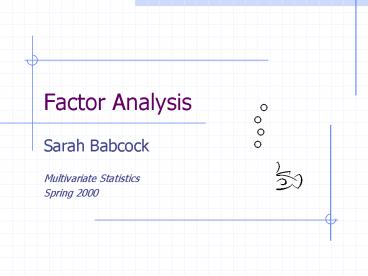Factor Analysis PowerPoint PPT Presentation
1 / 21
Title: Factor Analysis
1
Factor Analysis
- Sarah Babcock
- Multivariate Statistics
- Spring 2000
2
Variables
3
Self-Descriptions
- kind
- intelligent
- optimistic
- jealous
- attractive
- shy
- competitive
- loving
- humorous
- persistent
- honest
- sensitive
- generous
- aggressive
- influential
- stubborn
- creative
- active
- intense
- lazy
4
Factors
Each factor represents a cluster of variables
that correlate closely with one another
5
Factors
6
Factor Analysis family of data reduction
techniques used to summarize large amounts of
data and identify relationships among multiple
variables.
7
Why Factor Analysis?
- Often too many variables to manage
- Not always clear which variables are most
important - Variables are redundant
- Correlation coefficient analysis between
variables is useful, but soon becomes unwieldy
8
(No Transcript)
9
When to use Factor Analysis?
- Exploratory research
- Identification of underlying factors
- Screening of variables
- Data summarization
- Sampling of variables
- Clustering of objects
10
Data Input Matrix
- Observational or raw data
Variables
v1
v2 .
O1
O2
Objects
O3
O4
11
Correlation Matrix
- Calculate all correlation coefficients between
variables
Variables
v1
v2 .
v1
v2
Variables
v3
v4
12
Factors
13
Factor Matrix
- Factor loadings from -1.00 to 1.00 represent
degree to which each variable correlates with
each factor
14
Key Ideas
- Factor Loading - can be positive or negative and
high or low - Factor Scores (calculated for original objects as
a weighted combination of the scores on each
input variable) - High factor loadings mean high weights in
equation for calculating factor scores
15
Number of Factors to Extract?
- Latent Root Criterion (Eigenvalues)
- Represents variance accounted for by factor
- Retain factors with values above 1.0 only
- A Priori Criterion
- Percentage of Variance Criterion
- Scree Test Criterion
- Scree accumulation of stony rubble at the base
of a hill or cliff - Graph of data allows researcher to get the big
factors and eliminate the scree
16
Rotation of Factors
- Redefinition of factors such that loadings are
very high or very low - Can help in data interpretation
- Methods of rotation
- orthogonal (90 degree) and oblique methods
- Varimax (simplifies columns)
- Quartimax (simplifies rows)
- Equimax (rows and columns)
- Oblimin (used in SPSS)
17
Factor Analysis Tables
- Tabular presentation (Factors with the associated
variables listed below) - GOODNESS Factor Loadings
- Kind .71
- Generous .66
- Jealous - .51
- Sensitive .31
18
Factor Analysis Graphs
- Graphical presentation of results
19
Criticism of Factor Analysis
- There is great danger of assigning misleading or
subjective factor names - Factors are often obvious, making complex
computer analysis unnecessary - Factor analysis is subject to researcher bias
Garbage In...Garbage Out
20
The End
21
(No Transcript)

